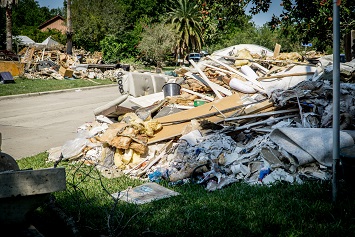The EPA has issued a draft update of Planning for Natural Disaster Debris (Planning Guidance), the Agency’s main guidance for cities, counties, and tribes the EPA says should engage in comprehensive waste management planning before a disaster. According to the Agency, planning can help communities recover faster, spend less money on cleanup and debris/waste management, and use fewer resources to rebuild and recover.
The draft was prepared by the EPA’s Office of Resource Conservation and Recovery, which also issued two accompanying drafts, Pre-incident All-hazards Waste Management Plan Guidelines: Four-step Waste Management Planning Process and an All-hazards Waste Management Decision Diagram for Homeland Security Incidents. The three drafts can be accessed here. The Agency is accepting public comments on the documents until June 26, 2018.
The draft Planning Guidance updates a 2008 version of the document with a heavier focus on preliminary and preplanning efforts related to natural disaster debris management. Incorporated into the draft are discussions of the impacts community resiliency, climate change adaptation, and hazard mitigation efforts have on disaster debris management. Also included are new case studies on the responses to the 2011 Joplin tornado, 2012 Hurricane Sandy in New York City, and 2015 St. Louis area floods.
The Costliest Year—2017
The rewrite appears to be motivated by an increased rate of occurrence of natural disasters in the United States and the dollar values attached to resulting damage. According to the draft, the National Oceanic and Atmospheric Administration (NOAA) estimates that from 1980 to 2017, the United States experienced 219 natural disasters that resulted in at least $1 billion in damage, costing the United States more than $1.5 trillion. Ten of these disasters occurred in 2015; 15 occurred in 2016. In 2017, 16 disasters occurred, resulting in the most expensive year on record for disasters, with $306.2 billion in cumulative damages. This total replaces the previous annual record cost of $214.8 billion (adjusted for inflation) in 2005, which resulted from the combined impact of Hurricanes Dennis, Katrina, Rita, and Wilma.
Also, while the current administration tends to avoid discussing the impacts of climate change, the draft has no such reservations, noting on its first page that the 2014 National Climate Assessment states that climate change is expected to increase the frequency and intensity of some natural disasters.
“The amount of debris generated by natural disasters, and the costs to manage it, will likely increase as a result,” states the EPA.
Fostering Coordination and Relationships
Among its many planning recommendations, the Planning Guidance urges that communities follow the whole community approach contained in the National Response Framework developed by the Federal Emergency Management Agency (FEMA). In that document, whole community is explained as “a focus on enabling the participation in national preparedness activities of a wider range of players from the private and nonprofit sectors, including nongovernmental organizations and the general public, in conjunction with the participation of federal, state, and local governmental partners in order to foster better coordination and working relationships.”
Whole community planning can aid local governments that alone may not have the means to develop a disaster debris plan, says the EPA. More information on building an integrated and effective whole community framework is at https://www.fema.gov/whole-community.
Disasters, Large and Small
In the most basic terms, planning for postdisaster debris comprises four steps:
- Source reduction and hazard mitigation activities to reduce the amount and toxicity of debris generated by a natural disaster;
- Strategies for reuse and recycling of materials to minimize the environmental and economic impact of debris management activities;
- Roles and responsibilities for all debris management and related activities; and
- Issues and considerations beyond initial debris removal.
The Planning Guidance strongly recommends that preincident planning be documented in a debris management plan.
“Although the officials who contributed to this document recognize that even the best debris management plan cannot account for every situation, having a plan is important because it lays the groundwork for a community’s preparedness and response to a natural disaster, particularly if it has widespread impacts,” states the EPA. “To be comprehensive, communities are encouraged to develop debris management plans that are scalable to both large and small natural disasters.”
Planners can follow Pre-incident All-hazards Waste Management Plan Guidelines: Four-step Waste Management Planning Process or, if resources and time are limited, can focus on one or more preincident planning activities at a time.


